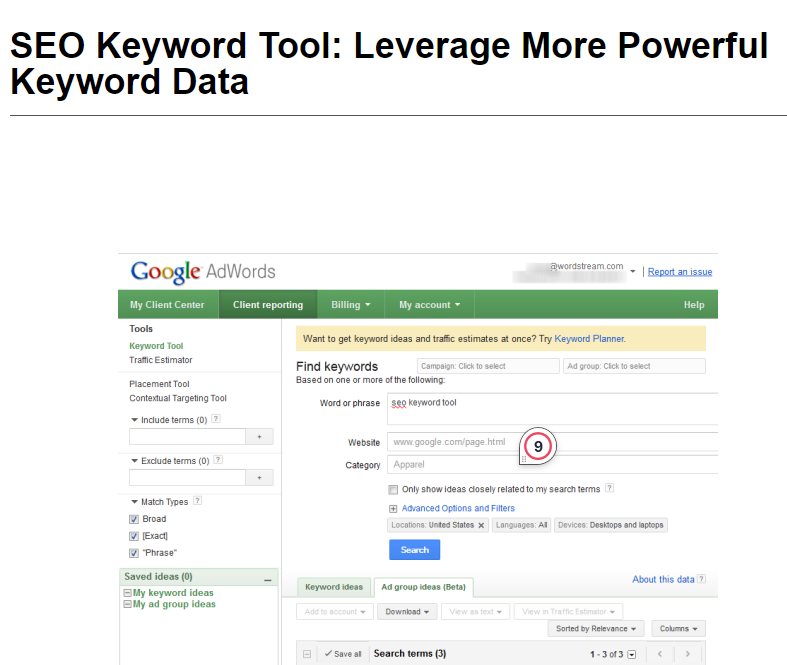
Leveraging SEO Keyword Advertising for Optimal Results

Key Highlights
- SEO keyword advertising involves strategically targeting relevant keywords to boost website visibility in search results and increase traffic.
- Comprehensive keyword research is crucial for identifying high-value keywords aligned with your target audience's search intent.
- When choosing keywords, consider search volume, competition, and relevance to your content.
- Effective keyword integration should feel natural within the content, improving its readability and SEO performance.
- Regularly analyze keyword performance metrics to refine your strategy and adapt to evolving search trends.
Introduction
In today's digital landscape, a strong online presence is paramount for business success. This is where search engine optimization (SEO) comes into play. As a vital marketing strategy, SEO helps your website rank higher in search results, making it more visible to a wider audience. And at the core of SEO lies the power of keyword research. This involves identifying the terms your potential customers use when searching for products or services like yours. By understanding and strategically utilizing these keywords, businesses can significantly enhance their website's visibility and attract valuable organic traffic.
Understanding SEO Keyword Advertising

SEO keyword advertising leverages the power of SEO keywords to improve a website's ranking in search engine results pages (SERPs). By optimizing content around relevant keywords, businesses can enhance their visibility and attract more qualified traffic. Think of it this way: every time someone types a query into a search engine like Google, they are essentially expressing a need. SEO keyword advertising aims to ensure that when someone searches for products, services, or information related to your business, your website appears among the top results.
This strategic approach not only drives more traffic but also targets the right audience – those actively seeking what you offer. By aligning your website content with specific search terms, you increase the likelihood of attracting users genuinely interested in your offerings.
Defining SEO Keyword Advertising
SEO keyword advertising is not just about stuffing your content with as many keywords as possible; in fact, that tactic can harm your ranking. It's about understanding the search behavior of your target audience and strategically incorporating relevant keywords into your website's content, meta descriptions, and other elements.
The goal is to make it crystal clear to search engines what your website is about so they can confidently display it in relevant search results. Unlike paid advertising platforms like Google Ads, where businesses bid on keywords to display advertising campaigns prominently at the top of search results pages, SEO keyword advertising focuses on organic traffic generation.
The Importance of Keywords in Digital Marketing
In the realm of digital marketing, keywords act as the bridge connecting your target audience with your online content. Relevant keywords, strategically woven into your website's fabric, serve as signposts guiding search engines to understand the context and relevance of your content.
Imagine you own a bakery - using keywords like "artisan bread," "custom cakes," or "pastries near me" helps paint a clear picture for search engines about your offerings. By understanding the search terms your target audience uses, you can tailor your content to match their intent, ultimately driving more qualified traffic to your site and increasing conversions. In essence, effective keyword utilization ensures that your bakery appears in search results when customers are looking for delicious treats just like yours!
The Role of Keyword Research in SEO Advertising

Before you embark on any SEO keyword advertising endeavor, you need to lay a solid foundation with thorough keyword research. This process is about identifying those valuable keywords that not only resonate with your target audience but also align with your business goals.
A keyword research tool like Semrush, Ahrefs, or even Google’s Keyword Planner can be tremendously helpful in this regard. These tools provide insights into search volume, competition, and other essential metrics, enabling you to prioritize keywords and create a winning keyword strategy.
Starting with Keyword Research: A Step-by-Step Approach
Embarking on the keyword research process might seem daunting at first, but it can be broken down into manageable steps. Here’s a straightforward approach:
- Define Your Niche: Begin by clearly outlining your business niche, products, and services. What specific area of expertise do you operate within?
- Brainstorm Seed Keywords: Based on your niche, jot down a list of keywords that potential customers might use when searching for your products or services.
- Utilize Keyword Research Tools: Input your seed keywords into Google’s Keyword Planner or other tools to generate a more comprehensive list of relevant terms.
Tools and Techniques for Effective Keyword Discovery
A plethora of keyword research tools are at your disposal, each offering unique features and insights. While Google's Keyword Planner remains a popular choice, exploring other options like SEMrush, Ahrefs, Moz Keyword Explorer, and Ubersuggest can provide a competitive edge.
These tools not only offer keyword suggestions based on seed terms but also provide valuable data points like:
- Search Volume: Understand how many people are searching for specific keywords.
- Competition: Gauge the level of competition for ranking for specific terms.
- Cost-per-Click (CPC): Estimate the potential cost of advertising for specific keywords.
Leveraging a combination of these best keyword research tools empowers you to gain a comprehensive understanding of the keyword landscape and make data-driven decisions.
Crafting Your SEO Keyword Strategy
Choosing the right keywords is only half the battle; the real magic happens when you weave them strategically into your keyword strategy. This strategy will be your roadmap to achieving sustainable, long-term SEO success.
Consider factors like search volume, competition, and relevance to your content when prioritizing keywords. A well-crafted strategy allocates resources effectively, focusing efforts on keywords most likely to deliver a high return on investment.
Selecting the Right Keywords for Your Campaign
When it comes to selecting the best keywords for your keyword advertising campaign, striking a balance between relevancy, search volume, and competition is key. High-volume keywords might seem appealing, but if they are irrelevant to your offerings or face fierce competition, they might not yield the desired results.
Focus on keywords closely aligned with your target audience's needs and search intent. Incorporate a mix of head terms (broad keywords with high search volume) and long-tail keywords (more specific phrases with lower search volume but often higher conversion rates) for a well-rounded approach. Additionally, prioritize keywords with a reasonable monthly search volume, indicating sufficient demand to warrant your optimization efforts.
Balancing Between Broad and Long-Tail Keywords
Effectively incorporating both broad and long-tail keywords is crucial for a well-rounded SEO keyword strategy. While broad keywords cast a wide net, targeting a larger audience with general terms, long-tail keywords cater to users with a more specific search intent.
Consider this example: if you're a florist, a broad keyword could be "flowers," whereas a long-tail keyword would be "wedding bouquets with lilies and roses." The latter indicates a clearer purchase intent and targets a more qualified audience.
Balancing these keyword types ensures that you attract a broad range of users, satisfying both general inquiries and those with specific search needs.
Optimizing Your Content with Keywords

Having a robust keyword strategy is pointless unless implemented effectively. This is where content optimization comes into play. Seamlessly integrate your target keywords into your website's content, ensuring it feels natural and engaging for readers.
Avoid keyword stuffing, which can lead to a negative user experience and harm your search rankings. Instead, prioritize creating high-quality, informative content that satisfies user intent and naturally incorporates your chosen keywords. Consider strategic placement within the title tag, meta description, headers, and throughout the body of your landing page or blog posts.
Integrating Keywords into Your Website Content
Once you have your list of target keywords, it’s time to put them to work. One of the most effective SEO tips is to integrate these keywords naturally within your website content. This involves more than just inserting keywords randomly; it requires a strategic approach that enhances readability and relevance.
Start by incorporating your primary keyword into the title tag, headers, and meta description. Then, seamlessly weave related keywords throughout your blog post or page content. Remember to use variations of your target keywords to avoid sounding repetitive. For example, instead of constantly using “best running shoes,” try incorporating phrases like “top-rated running shoes,” “comfortable running footwear,” or “shoes for marathon runners” – all while ensuring the content remains coherent and engaging.
Best Practices for Keyword Density and Placement
While incorporating keywords is essential, overdoing it (keyword stuffing) can harm your SEO efforts. Keyword density, which refers to the percentage of times a keyword appears on a page relative to the total word count, should feel natural and not disrupt the flow of the content.
Generally, aim for a keyword density of 1-2% for optimal results. Focus on strategic keyword placement – incorporate your primary keyword in the title tag, early on in the body content (first paragraph), and within at least one subheading. Distribute related keywords naturally throughout the text, ensuring that the content reads well for visitors. Always prioritize a user-centric approach, creating content that caters to your target audience's needs and questions while subtly integrating relevant keywords as part of a comprehensive content strategy.
Advanced Keyword Optimization Techniques
As you become more comfortable with the basics of keyword optimization, consider exploring advanced techniques to gain a competitive advantage. LSI keywords, for example, are terms semantically related to your primary keyword and can help search engines better understand the context of your content. Another powerful tactic involves analyzing keyword difficulty, which indicates how challenging it would be to rank for a specific term.
By understanding and incorporating these advanced SEO strategies, you can further enhance your website's visibility and drive even more targeted traffic.
Using LSI Keywords to Boost SEO Performance
LSI keywords, or Latent Semantic Indexing keywords, play a crucial role in enhancing SEO performance. Unlike simply repeating your primary keyword multiple times, LSI keywords are terms semantically related to your main topic. Think of them as supporting keywords that provide context and depth to your content.
For instance, if your primary keyword is "apple pie recipe," LSI keywords could include "best apples for pie," "pie crust recipe," or "apple pie baking tips." Incorporating these related keywords naturally within your content not only makes it more comprehensive and informative for readers but also signals to search engines that you have a deep understanding of the topic.
The Role of Keyword Difficulty in Strategy Planning
Understanding keyword difficulty is crucial for effective strategy planning. It essentially tells you how much effort is required to rank for a specific keyword. A high keyword difficulty score indicates fierce competition, meaning it will require significant effort and resources to secure a top spot in the search results. Conversely, lower difficulty keywords present a better chance of ranking well, especially for newer websites with less established domain authority.
Here's a simple table illustrating keyword difficulty:
Keyword Difficulty
Description
Low
Easier to rank for; less competition
Medium
Moderate competition; requires more effort
High
Highly competitive; challenging to rank
By considering keyword difficulty during the planning stage, you can prioritize your efforts, focusing on keywords that align with your website's authority and provide a realistic opportunity to improve your search rankings.
Measuring the Success of Keyword Advertising
Simply implementing a keyword strategy isn't enough; it's crucial to measure its effectiveness and make adjustments as needed. Tools like Google Analytics will be your best friend in this regard. They offer a wealth of data, providing insights into how users interact with your website and which keywords drive the most valuable traffic.
Measuring success in keyword advertising is an ongoing process, not a one-time task. Regularly monitor your chosen keywords' performance, analyzing metrics like organic traffic, click-through rates, and conversion rates. Understanding these key metrics provides valuable insights into what's working and what might need adjustments to optimize your campaigns further.
Key Metrics to Track in Your SEO Campaign
Tracking the right metrics is essential for understanding the effectiveness of your SEO campaign. Google Analytics, your go-to tool for performance tracking, provides a treasure trove of data, but knowing which key metrics to focus on is crucial.
Here are some essential metrics to keep an eye on:
- Organic Traffic: Track the number of visitors coming to your website from organic search results.
- Keyword Rankings: Monitor your website's position in search results for your chosen keywords.
- Click-Through Rate (CTR): Measure the percentage of users who click on your website link in search results.
By regularly monitoring and analyzing these metrics, you can gain valuable insights into the performance of your keywords and identify areas for improvement.
Adjusting Your Strategy Based on Analytics Insights
SEO is not a static process; it requires continuous monitoring and strategy adjustment based on performance data. Analytics insights provide invaluable guidance for refining your approach and maximizing your return on investment.
Regularly review your keyword performance, identifying any significant fluctuations or drops in rankings. Utilize tools like Google Trends to stay updated on evolving search trends and adjust your keyword strategy accordingly. Don't hesitate to experiment with new keywords or refine your existing ones based on the data.
KeywordSearch: SuperCharge Your Ad Audiences with AI
KeywordSearch has an AI Audience builder that helps you create the best ad audiences for YouTube & Google ads in seconds. In a just a few clicks, our AI algorithm analyzes your business, audience data, uncovers hidden patterns, and identifies the most relevant and high-performing audiences for your Google & YouTube Ad campaigns.
You can also use KeywordSearch to Discover the Best Keywords to rank your YouTube Videos, Websites with SEO & Even Discover Keywords for Google & YouTube Ads.
If you’re looking to SuperCharge Your Ad Audiences with AI - Sign up for KeywordSearch.com for a 5 Day Free Trial Today!
Conclusion
In conclusion, mastering SEO keyword advertising is pivotal for achieving optimal digital marketing results. By understanding the significance of keywords, conducting thorough research, crafting a strategic approach, and continuously optimizing content, you can enhance your online visibility and drive targeted traffic to your website. Leveraging advanced techniques like LSI keywords and analyzing key metrics for performance evaluation are crucial steps in ensuring the effectiveness of your keyword advertising efforts. Regularly updating your keyword strategy based on analytics insights and aligning SEO and PPC campaigns can further amplify your online presence and engagement. Stay proactive, stay relevant, and watch your digital success soar.
Frequently Asked Questions
How Often Should I Update My Keyword Strategy?
The digital landscape is constantly shifting, so regularly reviewing and updating your keyword strategy is essential. While there's no set schedule, aim for a review every quarter, or more frequently in dynamic industries. Tools like Google Search Console and staying informed about search engine marketing trends can help you identify relevant search terms that need attention.
Can I Use the Same Keywords for SEO and PPC?
While there can be overlap, using the same keywords for SEO and PPC isn't always ideal. PPC often targets more immediate conversions, while SEO focuses on long-term organic growth. Aligning keywords within your Google Ads account with your advertising goals is best, even if they share similarities with your organic keywords.
What’s the Difference Between Short-Tail and Long-Tail Keywords?
Short-tail keywords are shorter, broader search terms with higher search volume but more competition (e.g., "shoes"). Long-tail keywords, on the other hand, are longer, more specific keyword phrases with lower search volume but often a more defined target audience (e.g., "comfortable running shoes for women").
